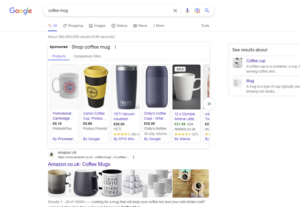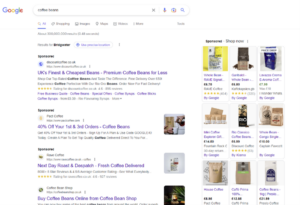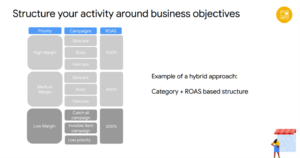Why The Quality Of Your Google Shopping Feed Matters
Written by Zoey Reading
If you are running an e-commerce business then it’s likely you have heard of Google shopping campaigns. A Google shopping campaign is incredibly useful to e-commerce businesses as it can bring higher-quality traffic to each of your products. You may have seen these ads before. If you search on Google they pop up at the top of your search.

They can also pop up on the right-hand side.

Before you can set a shopping campaign up you need to make sure you have a Google shopping feed. Because Google shopping campaigns don’t bid directly on keywords you need a shopping feed so Google knows what queries are relevant to show your ad for. The better your shopping feed, the more accurate the search queries you show up for are!
What is a shopping feed?
A feed is a list of all your products that you want to advertise through Google Merchant Center. You add your products and assign attributes for each one. A feed uses these attributes to group products together essentially making your life a whole lot easier!
There are several types of feeds in Merchant Center, which you use depends on your needs as a business and the capabilities for pulling product-level information from your site into a feed. Which attributes you assign to your products are the same throughout these feeds.
Requirements for a primary shopping feed
A primary feed is the main data source for your inventory in Merchant Center. If each product in that feed meets Google Merchant Center’s requirements, you shouldn’t need to create any more feeds.
In order for your products to serve, there are certain attributes your product feed has to have on each product before your products are approved:
- Product ID – an identifier for your products.
- Title – The name of your product.
- Description – The details of your product.
- Link – Where you are sending the people clicking on your ad.
- Image – A clear image of the product you are selling.
- Availability – If your product is in stock.
- Price – How much your product costs.
Once you have these on each product in your feed then you are ready to set up your shopping campaign. There are other attributes you can add into your feed that aren’t required but very helpful to have:
- Expiry date – if the product is consumable.
- Sale price – if your product is on sale.
- Google product category – For example food & beverages, electronics, arts & entertainment.
- Product type – For example if it’s a dress, what type of dress e.g. maxi, mini, prom.
- Product size – For example shoe size.
How to fix quality issues in Merchant Center
You might head into your Merchant Center and see that you have some disapproved items. This can be for a variety of reasons. Your product feed can impact how many disapproved items you have if you are missing any key attributes on your product.
For example, these are some of the things you need to make sure are in your feeds in Merchant Center,
- Product Image – This needs to be the correct size and have no writing covering the image.
- Titles that are a maximum of 150 characters, anything over will be disapproved.
- Information on the feed matches the website – Make sure the price is the same.
- Shipping info – If there isn’t shipping you need to make sure it’s stated.
It’s important to keep your items approved, if you have disapproved items, ads for those products won’t serve and therefore you won’t get any sales. Some items are not allowed to be sold on Google shopping which violates Google policies so make sure your products don’t go against Google policies. Sometimes products are disapproved incorrectly which you can submit an appeal for.
How to optimise your Google Merchant Center shopping feed
Once all of your products are approved, there are still some ways you can optimise your feeds to get the best out of your campaigns.
- Make sure you are putting relevant keywords in your product titles – These are words that relate to your product that people may be searching for. For example, if you are selling a pink sequin dress, make sure you are clearly stating these words, as well as adding in things like “women’s fashion” and “party dresses”. Don’t forget to make the most of your title length. A Merchant Center title can be up to 150 characters so make sure you are utilising this with keywords. Be mindful that the title makes sense and you are not just keyword stuffing.
- Add in GTINs – Although this is no longer a requirement, they are still worth putting in. GTINS help to distinguish whether a product is legitimate or not. They let customers compare items, so if you are competitive in price your customers will see this.
- Adding a custom label – These help you to group your products making it easier to separate out into relevant campaigns. This may be relevant for example, if you have different price points on your items you can segregate them into low, medium, high and so on. You can set separate budgets and adjust bids for each type of product depending on the average order value and potential return on investment.
- Adding a promotion – Sales and promotions often increase your chances of a customer clicking on your ad. You first create an attribute called “promotion_ID” and populate the items you want in the sale. Then you can set up the promotion in Google Merchant Center under the promotions tab. You can also create a promotion feed if you are going to be running promotions for long periods of time. You can also add a promotion directly to the brand without having to add a promotion ID.
The importance of having a quality shopping feed
It’s important to keep your feed optimised so that not only can your products serve, but they compete well with your competitors. Google will reward people who keep on top of disapproved products and have all the necessary attributes in their feeds. As well as the relevant keywords in your titles and descriptions.
Having a quality feed also means that you can manage your campaigns and products easily, getting the best out of your time and budget. By segmenting your product into custom labels, you are saving yourself time when you are adding and negating products to a campaign.
If you have an excellent shopping feed, you can then structure your shopping campaigns around your business objectives making sure you get the most from your investment.

If you are an e-commerce business that would like help with your Google Merchant Center or would like to get started, please contact us for more information. Happy Shopping… Feed!

